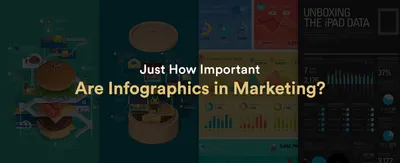Just How Important Are Infographics in Marketing?


In any given day, there are 2 million new blog posts, 500 million tweets, and almost 5 billion Facebook updates all uploaded onto the internet.
So, how exactly can you distil all of the new (and relevant) information into something more palatable for your audience?
Well, you could pull it all together into a roundup-style blog post, but that might end up a little ‘TL;DR’.*
Or you could create a weekly or monthly email newsletter, but not everyone is going to click through.
Which leads us to another option: Infographics.
You’re probably familiar with the concept of infographics; they’re a mix of design, writing, and data analysis, with the express purpose of delivering information in an easy-to-digest and engaging format.
We, as a species, are incredibly visual creatures. 70% of our sensory receptors can be found in our eyes, 50% of the brain is involved in visual processing, and we can make sense of visual information in less than one tenth of a second.
That’s why presenting big data and complex information as an infographic is so powerful. Using a clever combination of words, pictures, shapes, and colours allows the reader to get to the heart of a subject in less time than it takes to watch a video or read a blog post.
What’s more, the manner in which it's presented means this data is ready to be shared extensively via social media. In fact, HubSpot reported in 2014 that tweets containing infographics were retweeted 832% more than traditional posts, while people are three times more likely to share infographics than documents to social networks.
How Can Infographics Improve My Marketing?
Our attention spans are shorter than ever, and the way in which we market to our audience has evolved over the years.
The visual web (Facebook, Instagram, Pinterest) has demanded that we create more aesthetically pleasing pieces of content, which makes infographics the ideal cornerstone to a good marketing strategy.
Designing and sharing logically presented and strikingly distinct infographics will not only help you make complex data easier to understand, but also open it up to a wider audience; one that will look upon you as an expert in your field.
And that brings us to another important aspect of infographic marketing: Search Engine Optimisation (SEO).
Those of you with a passing understanding of SEO will know that the more high quality websites you have linking to your content, the more likely Google is to trust your content as a good quality resource in its own right. And with that trust comes the reward of a higher search engine ranking, even more links, and even more web traffic.
An attention-grabbing, unique infographic is still a terrific source of links and traffic, particularly if it taps into an important issue, or happens to “go viral”.
Well, with the ability to deliver important information to your audience in an easy-to-understand format, boost your search and social media performance, and position your business as a thought leader in your industry, we’d say they’re pretty damn important!
* ‘TL;DR’ stands for ‘Too Long; Didn’t Read.’ Hopefully this wasn’t.
Do you use infographics as part of your marketing strategy?
Do you have any favourites?
Share them with us on Twitter.
I live just outside of Manchester but I wasn't born here. I do love the city though.